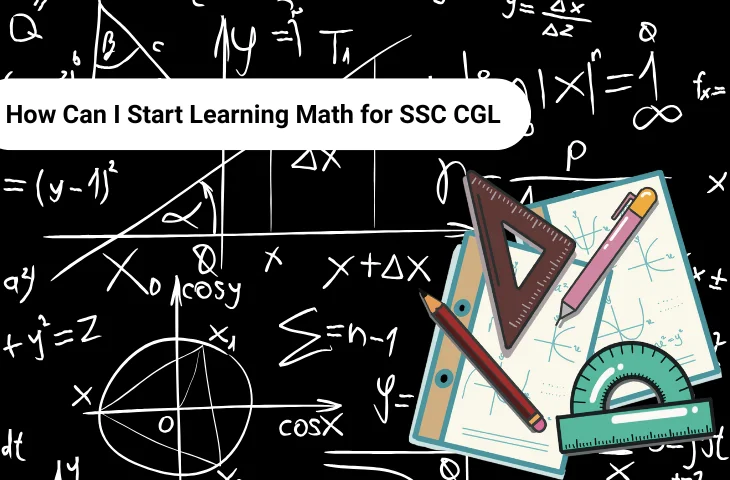Mathematics is one of the most important parts of the SSC CGL exam. Many aspirants find it difficult in the beginning, but with the right approach and resources, anyone can build strong math skills. In this blog, we have provided a step-by-step guide on how to start learning math for SSC CGL, covering syllabus topics, important formulas, strategies, and common mistakes to avoid while preparing.
Understand the SSC CGL Math Syllabus
Before starting preparation, it is important to know the exact SSC CGL syllabus. The math section in SSC CGL mainly covers the following topics:
Arithmetic
- Percentage
- Profit & Loss
- Discount
- Simple & Compound Interest
- Ratio & Proportion
- Average
- Mixture & Allegation
- Time & Work, Pipes & Cistern
- Time, Speed & Distance (Boats & Streams, Trains)
- Partnership
- Problems on Ages
Algebra
- Algebraic Identities
- Linear and Quadratic Equations
- Simplification
Geometry & Mensuration
- Lines and Angles
- Triangles (properties, congruence, similarity)
- Circles (tangent, chord, angle properties)
- Quadrilaterals & Polygons
- Mensuration (2D & 3D: cube, cuboid, cylinder, cone, sphere, hemisphere)
Trigonometry
- Trigonometric Ratios (sin, cos, tan, cot, sec, cosec)
- Trigonometric Identities
- Heights and Distances
Data Interpretation
- Bar Graphs
- Line Graphs
- Pie Charts
- Tabular Data
How to Build Strong Basics in SSC CGL Mathematics
If you are just starting, begin with the basics. Use NCERT books (Class 6–10) or any good foundation book. Focus on:
- Understanding concepts clearly
- Practicing simple problems first
- Improving calculation skills
A strong base helps you solve tricky questions in less time.
Important Formulas and Shortcuts for SSC CGL Math
Some of the important formulas are as follows:
Arithmetic
- Percentage = (Value / Total Value) × 100
- Profit % = (Profit / Cost Price) × 100
- Simple Interest = (P × R × T)/100
- Compound Interest = P(1 + R/100)ᵗ – P
- Average = Sum of values ÷ Number of values
- Speed = Distance / Time
Algebra
- (a + b)² = a² + b² + 2ab
- (a – b)² = a² + b² – 2ab
- a² – b² = (a + b)(a – b)
Geometry & Mensuration
- Area of Circle = πr²
- Circumference = 2πr
- Volume of Cylinder = πr²h
- Volume of Sphere = 4/3 πr³
- Surface Area of Sphere = 4πr²
Trigonometry
- sin²θ + cos²θ = 1
- 1 + tan²θ = sec²θ
- 1 + cot²θ = csc²θ
Topic-Wise Preparation Strategy for SSC CGL Math
The step-by-step preparation strategy for SSC CGL Maths is as follows:
- Start with Percentages & Ratio
- Move to Averages, Profit & Loss, SI & CI
- Practice Time & Work, Speed & Distance
- Cover Algebra, Geometry & Mensuration
- Revise Trigonometry and Data Interpretation
After each topic, solve practice questions and small quizzes to check your progress.
Why Previous Year Papers are Important for SSC CGL Math
Solving previous year papers gives you:
- A clear idea of exam pattern
- The difficulty level of questions
- Repeated and high-weightage topics
Try to solve at least the last 5–6 years’ papers before the exam.
Role of Mock Tests in SSC CGL Math Preparation
Mock tests are essential for practice. SSC CGL Mock Tests help you to:
- Improve speed and accuracy
- Manage exam time effectively
- Identify weak areas for revision
Start with 1 mock test per week and gradually increase frequency.
How to Improve Speed and Accuracy in SSC CGL Math
The SSC CGL exam requires solving questions fast without compromising accuracy. Start with accuracy by solving questions step by step. Once concepts are clear, try:
- Timed practice: Solve 20–25 questions in a fixed time.
- Short tricks: Learn methods for squares, cubes, and multiplication.
- Error analysis: Review mistakes after every test.
Remember, accuracy is more important than attempting all questions.
Daily Practice and Revision Tips for SSC CGL Mathematics
- Dedicate 1–2 hours daily to math practice
- Revise formulas at least twice a week
- Maintain a “mistake notebook” for weak areas
- Mix easy and tough questions in your daily practice
Consistency is the key to mastering math.
Common Mistakes to Avoid in SSC CGL Math Preparation
Many aspirants lose marks in math due to common mistakes such as:
- Ignoring topics like Geometry and Trigonometry
- Depending only on tricks without understanding concepts
- Not revising formulas regularly
- Skipping mock test analysis
- Studying from too many books at once
Consistency and Smart Study Plan
The secret to mastering math for SSC CGL is consistency. Even one hour of focused math practice daily is better than irregular study. Create a study plan that includes:
- Daily Practice: At least 20–30 questions from different topics
- Weekly Revision: Revise all formulas and concepts once a week
- Regular Tests: Attempt mock tests to track progress
FAQs
There are 25 questions in Tier 1, each carrying 2 marks.
2–3 hours of focused practice daily is enough for steady progress.
No, with consistent practice and clear concepts, it becomes manageable.
Build accuracy first, then gradually increase speed with timed practice.
Revise daily for the first month, then weekly until the exam.
- Delhi Police HCM Exam Date 2025 Out, CBT scheduled from 7th to 12th January 2026
- Most Repeated Quantitative Aptitude Questions for SSC CHSL Tier 2
- Most Repeated Reasoning Questions For SSC CHSL Tier 2, Download PDF
- SSC CGL 2025 Tier 1 PYPs, Shift-Wise Previous Papers, Download PDFs
- SSC CGL Tier 2 Paper 1 Preparation Tips, Check now
- Delhi Police Vacancy 2025, Check Exam wise vacancies

Hi, I’m Aditi. I work as a Content Writer at Oliveboard, where I have been simplifying exam-related content for the past 4 years. I create clear and easy-to-understand guides for JAIIB, CAIIB, and UGC exams. My work includes breaking down notifications, admit cards, and exam updates, as well as preparing study plans and subject-wise strategies.
My goal is to support working professionals in managing their exam preparation alongside a full-time job and to help them achieve career growth.
